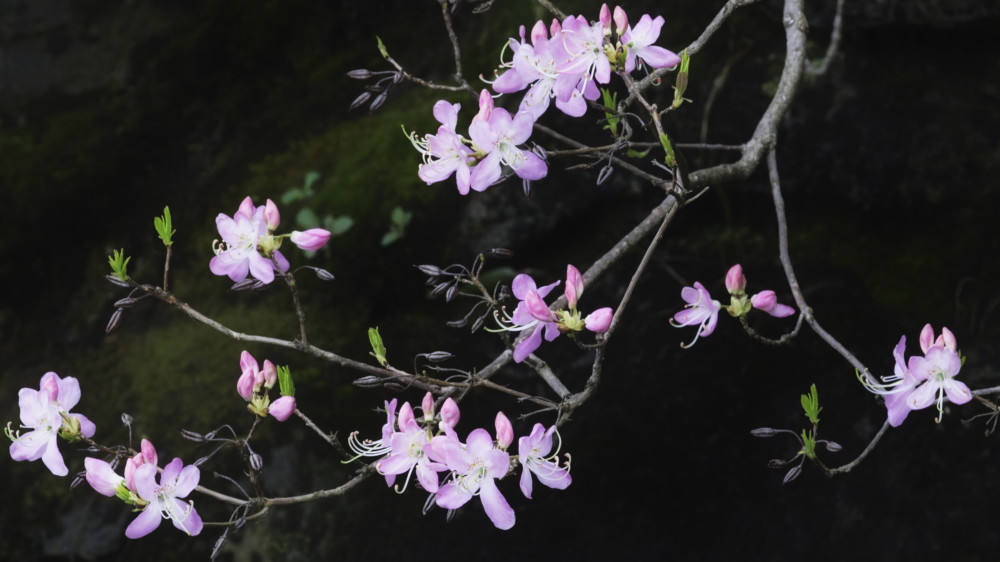
Endangered Species
Hundreds of species of plants and animals call Grandfather Mountain home. While some are commonly found and admired, others are rare — not only in North Carolina, but throughout the world. You may not see these on your visit (or, you just might!), but we’re all grateful that they’re as protected on our slopes as the mountain itself.
Grandfather’s Endangered Species
The North Carolina Wildlife Resources Commission, North Carolina Natural Heritage and the Nature Conservancy have conducted surveys of the plants and animals on Grandfather Mountain and have ranked the endangered species according to rarity.

G1 – Critically imperiled globally – At very high risk of extinction or collapse due to very restricted range, very few populations or occurrences, very steep declines, very severe threats or other factors.
- Gray’s Lily | Lilium grayi (vascular plant)
Gray’s Lily

Heller’s Blazing Star

Blue Ridge Goldenrod
G2 – Imperiled Globally – At high risk of extinction or collapse due to restricted range, few populations or occurrences, steep declines, severe threats, or other factors.
- Spruce-Fir Moss Spider | Microhexura montivaga (arachnid)
- Blue Ridge Goldenrod | Solidago spithamaea (vascular plant)
- Spreading Avens | Geum radiatum (vascular plant)
- Heller’s Blazing Star | Liatris helleri (vascular plant)
- Velvet Covert | Inflectarius subpalliatus (mollusk)
- *Grandfather Mountain Leptodontium Moss | Leptodontium viticulosoides var. sulphureum (moss)
- Bent avens | Geum geniculatum (vascular plant)
- *Roan Mountain Bluet | Houstonia purpurea var. montana (vascular plant)
- Pinebarren Death-Camas | Zigadenus leimanthoides (vascular plant)
- Bazzania nudicaulis (liverwort)
- High Mountain Supercoil | Paravitrea andrewsae (mollusk)
- Bog Turtle | Glyptemys muhlenbergii (reptile)
- Northern Long-eared Bat | Myotis septentrionalis (mammal)

Pink-shell Azalea
G3 – Vulnerable Globally – At moderate risk of extinction or collapse due to a fairly restricted range, relatively few populations or occurrences, recent and widespread declines, threats, or other factors.
- Appalachian Scalewort | Frullania appalachiana (liverwort)
- Rock Gnome Lichen | Cetradonia linearis (lichen)
- Weller’s Salamander | Plethodon welleri (amphibian)
- Plagiochila austinii (liverwort)
- Trailing Wolfsbane | Aconitum reclinatum (vascular plant)
- Wretched Sedge | Carex misera (vascular plant)
- Tall Larkspur | Delphinium exaltatum (vascular plant)
- Pink-shell Azalea | Rhododendron vaseyi (vascular plant)
- Southern Pygmy Salamander | Desmognathus wrighti (amphibian)
- Mountain Bittercress | Cardamine clematitis (vascular plant)
- Carolina Saxifrage | Micranthes caroliniana (vascular plant)
- Roan Mountain Rattlesnake-root | Prenanthes roanensis (vascular plant)
- Sullivant’s Leafy Liverwort | Plagiochila sullivantii (liverwort)
- Triangular Woodgrain Moth | Morrisonia triangula (insect)
- Three-horned Sallow Moth | Pachypolia atricornis (insect)

Virginia Big-eared Bat
S1 – Critically imperiled in North Carolina – At very high risk of extirpation in the jurisdiction due to very restricted range, very few populations or occurrences, very steep declines, severe threats or other factors.
- Peregrine Falcon | Falco peregrinus (bird)
- Plagiochila virginica (lichen)
- Rota’s Feather Moss | Brachythecium rotaeanum (moss)
- *Virginia Big-eared Bat | Corynorhinus townsendii virginianus (mammal)
- Lime Homalia | Homalia trichomanoides (moss)
- Pale-margined Leptodontium | Leptodontium flexifolium (moss)
- Canada Reedgrass | Calamagrostis canadensis (vascular plant)
- Hemlock Parsley | Conioselinum chinense (vascular plant)
- Fragile Fern | Cystopteris fragilis (vascular plant)
- Matted Feather Moss | Sciuro-hypnum populeum (vascular plant)
- Metzgeria temperata (liverwort)
- Taylor’s Flapwort | Mylia taylorii (liverwort)
- Northern Peatmoss | Sphagnum capillifolium (moss)
- Sharp-shinned Hawk | Accipiter striatus (bird)
- *Smyth’s Green Comma | Polygonia faunus smythi (butterfly)

Saw-whet Owl
S2 – Imperiled in North Carolina – At high risk of extirpation in the jurisdiction due to restricted range, few populations or occurrences, steep declines, severe threats or other factors.
- Eastern Small-footed Bat | Myotis leibii (mammal)
- Magnolia Warbler | Setophaga magnolia (bird)
- Red Crossbill | Loxia curvirostra (bird)
- Purple Willowherb | Epilobium ciliatum (vascular plant)
- Carolina Northern Flying Squirrel | Glaucomys sabrinus coloratus (mammal)
- Northern Saw-whet Owl | Aegolius acadicus (bird)
- Black-billed Cuckoo | Coccyzus erythropthalmus (bird)
- Yellow-bellied Sapsucker | Sphyrapicus varius (bird)
- Lofty Microcaddisfly | Palaeagapetus celsus (insect)
- Currant Eulithis Moth | Eulithis propulsata (insect)
- Barred Angle Moth | Macaria subcessaria (insect)
- Three-horned Sallow Moth | Pachypolia atricornis (insect)
- Hooked Silver Y Moth | Syngrapha alias (insect)
- Sand-loving Iceland Lichen | Cetraria arenaria (lichen)
- Alpine Camouflage Lichen | Melanelia stygia (lichen)
- Plagiochila exigua (liverwort)
- Horsehair Threadwort | Sphenolobopsis pearsonii (liverwort)
- Tufted Bulrush | Trichophorum cespitosum (vascular plant)

Appalachian Fir Clubmoss
S3 – Vulnerable in North Carolina – At moderate risk of extirpation in the jurisdiction due to a fairly restricted range, relatively few populations or occurrences, recent and widespread declines, threats or other factors.
- *Southern Appalachian Woodrat | Neotoma floridana haematoreia (mammal)
- Wood’s Sedge | Carex woodii (vascular plant)
- Appalachian Fir Clubmoss | Huperzia appalachiana (vascular plant)
- Hermit Thrush | Catharus guttatus (bird)
- Appalachian Cottontail | Sylvilagus obscurus (mammal)
- Brown Creeper | Certhia americana (bird)
- Northern Shorthusk | Brachyelytrum aristosum (vascular plant)
- Micrasema burksi (insect)
- Formosa Looper Moth | Chrysanympha formosa (insect)
- Pale-marked Angle Moth | Macaria signaria (insect)
- Triangular Woodgrain Moth | Morrisonia triangula (insect)
Not listed but otherwise rare or historical sightings – These species were observed at Grandfather Mountain at one time. At this time, there is not enough evidence to confirm their presence or absence.
- Waterfan | Peltigera hydrothyria (lichen)
- *Balsam Ragwort | Packera paupercula var. paupercula (vascular plant)
- Southern Water Shrew | Sorex palustris (mammal)
- Long-tailed Shrew | Sorex dispar (mammal)
- *Fruitful Locust | Robinia hispida var fertilis (vascular plant) Historical
- Roseroot Stonecrop | Rhodiola rosea (vascular plant) Historical
- Large Cranberry | Vaccinium macrocarpon (vascular plant) Historical
- *Southern Appalachian Black-capped Chickadee | Poecile atricapillus practica (bird) Historical
*implies a subspecies
